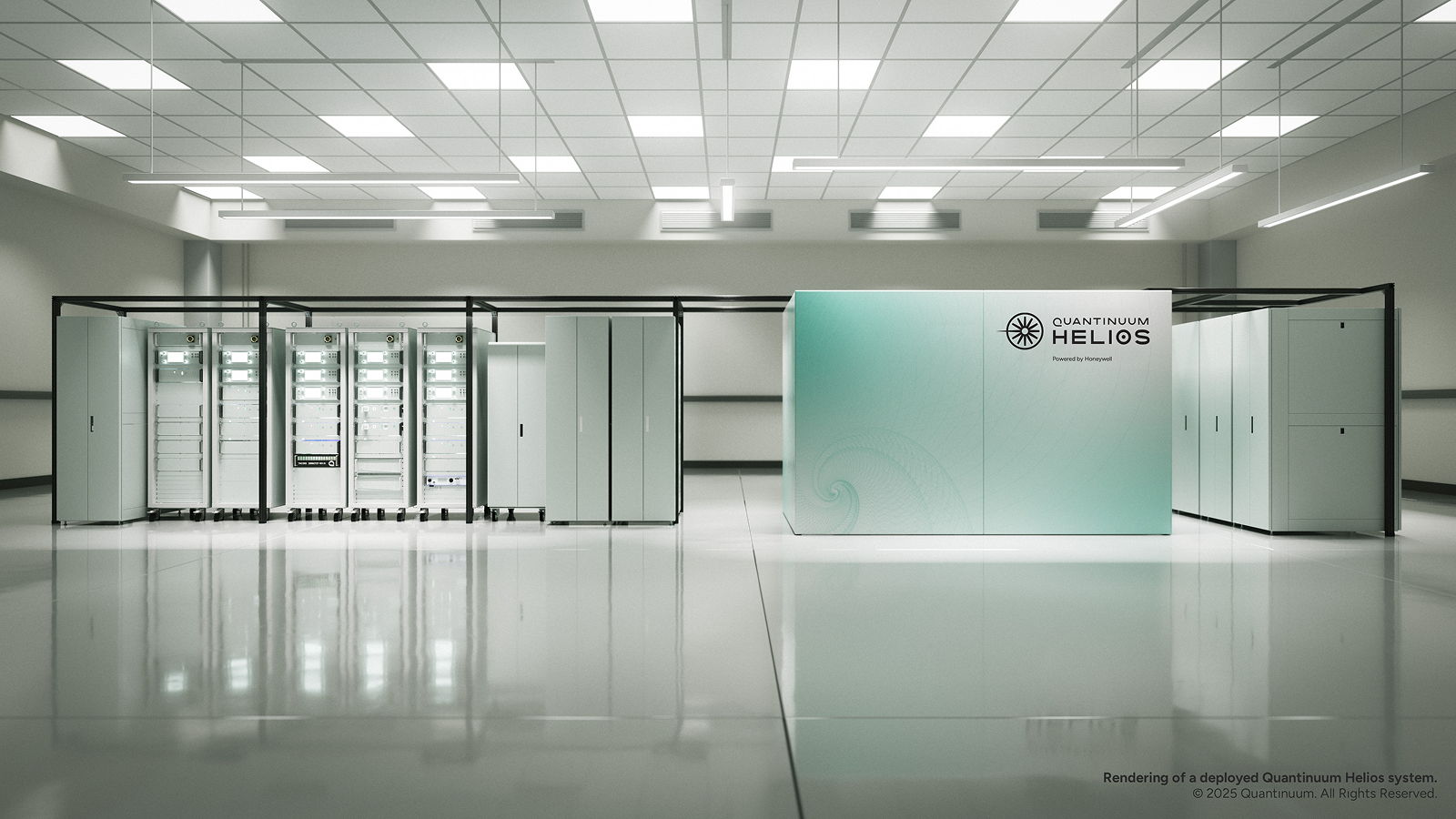'This is easily the most powerful quantum computer on Earth': Scientists unveil Helios, a record-breaking quantum system
Scientists have built a 98-qubit machine that they say performs better than any other quantum computer in the world. They've used it to gain new insights into superconducting physics.

Scientists at Quantinuum have unveiled the world's most powerful quantum computer. The team claims the new system is capable of solving a problem that a supercomputer could handle only if it consumed more power than the total wattage of a quasar — one of the brightest objects in the universe.
At the heart of the new machine, known as Helios, is a quantum processing unit (QPU) with 98 physical qubits made of barium ions. These qubits are arranged in a "junction ion trap" formation — a small, ring-like structure that forms a crossover junction at the base, before extending into two parallel rods.
This unique arrangement of qubits boosts error detection and correction to render much better performance than existing QPUs when running calculations, the scientists said. They described their findings in a new study published Nov. 5 by the Sandia National Laboratory in partnership with the company.
The scientists claim this is the most powerful quantum computer in the world, after it passed a series of benchmark experiments. They also used the machine to simulate a superconducting metal and made a new discovery about the atomic behavior of the material.
"Currently, this is easily the most powerful quantum computer on Earth," David Hayes, director of computational design and theory at Quantinuum, told Live Science. "I don't feel shy about that at all."
Anatomy of a quantum computer
Scientists meshed the 98 physical qubits into 48 fully error-corrected logical qubits (48 pairs with two spares) — collections of qubits that share data to minimize the chances of failure if an error were to occur in one of them. In doing so, the team achieved "better than break-even performance," Hayes said.
"Better than break-even performance" means the processor performs better in real-world calculations with error-correction codes applied than without any error-correction efforts — something that isn't as easy as it sounds.
Get the world’s most fascinating discoveries delivered straight to your inbox.
So far, scientists have assumed that they would need a 10:1 ratio for logical qubits (approximately 10 physical qubits entangled to create one logical qubit), Hayes said, but Quantinuum scientists got that down to 2:1.

They also ran experiments with 50 and 96 logical qubits, but the results weren't as impressive. Nevertheless, achieving good results with 46 will make it easier to build much larger machines in the future, when scientists scale them up to millions of qubits — which is necessary to outpace the fastest supercomputers, Hayes added.
In addition, the scientists created a new programming language, called Guppy, which is based on the widely used Python language and is designed to be compatible with future fault-tolerant systems. They also built a new control stack from scratch so that the control engine — the classical brain of the machine — could detect and resolve errors in real time.
The control engine works like a classical computer and designs the quantum circuits as they're running. Then, Helios uses Nvidia GPUs to decode error information and then send the corrections back to the quantum computer to reduce errors.
"It now has to think fast enough so that it can plan and change the quantum problem quickly enough so that the qubits aren't sitting around and dephasing and decohering [losing the delicate quantum state in which clacluations can run] and all this stuff," Hayes said. "We've finally mastered this real-time control engine that's necessary for fault tolerance, and it's an integral part of the new machine."
Quantum computing margin of error
"The thinking was, when we first started with [Quantinuum's previous QPUs] H1 and H2, we were just trying to get something running — build a system," Hayes said. "And as soon as we did it, we started looking into these quantum error correction experiments, and started realizing pretty quickly that we needed something else."
In the study, the machine scored much higher in various quantum computing benchmarking tests than any machine publicly unveiled so far. The QPU registered 99.921% fidelity across all qubit pairs and 99.9975% fidelity across single-qubit quantum gates (calculations that run on single qubits), they reported.

The benchmarking experiments included the widely used random circuit sampling (RCS) benchmark that Google first devised in 2019 and then pushed to the limits with its Willow QPU in 2024. Quantinuum broke that record last year with its 56-qubit H2-1 quantum computer.
Although many quantum computers have more physical qubits than the new system, performance depends more on the quality of the qubits — and minimizing their propensity to fail. This is why scientists have recently focused on quantum error correction (QEC).
This aims to address the extremely high error rate in qubits relative to bits in classical computing; 1 in 1 trillion bits fail in conventional computers, versus approximately 1 in 1,000 qubits in quantum computers (without any intervention or error-correction efforts).
Using quantum computers for new discoveries
To test out their new machine, the scientists used Helios to model a high-temperature superconducting metal to discover previously unknown electron behavior. They detailed the findings in another study published Nov. 3 to the arXiv preprint database.
In the study, they found that the electrons pair up through entanglement, such that they have a shared identity while the metal is in a superconducting state. This "signature of superconductivity" is not present when the metal is not superconducting, Hayes said.
The model was based on a previous experiment in which scientists shined a light on a chunk of metal — the recently discovered La3Ni2O — to make it superconducting at room temperature for a very short time. The simulation revealed the superconducting signatures. In a "wet lab" where you actually have the chunk of metal present, Hayes said, you can't see this behavior in individual electrons.
Scientists have previously run other experiments on analog quantum simulators — simple quantum systems that emulate more complex ones — that model how the chunk of metal might behave, Hayes noted. However, they can't measure the individual particles and examine them in the same way a digital quantum computer can. He added that the new machine is the first quantum computer capable of observing this phenomenon.
Having revealed the new quantum computing architecture, Hayes is confident that scientists can begin scaling it up so that many of these junction ion traps can work together in future machines.
"You can kind of think of it as a traffic intersection for the qubits to route them really efficiently and pair them up," Hayes said, referencing the junction following the ring in the new arrangement. "And now that we have this one working, we think that it should be pretty straightforward to insert a lot of these things trying to close the window into the next- generation machine and really scale these machines up to huge numbers."

Keumars is the technology editor at Live Science. He has written for a variety of publications including ITPro, The Week Digital, ComputerActive, The Independent, The Observer, Metro and TechRadar Pro. He has worked as a technology journalist for more than five years, having previously held the role of features editor with ITPro. He is an NCTJ-qualified journalist and has a degree in biomedical sciences from Queen Mary, University of London. He's also registered as a foundational chartered manager with the Chartered Management Institute (CMI), having qualified as a Level 3 Team leader with distinction in 2023.
You must confirm your public display name before commenting
Please logout and then login again, you will then be prompted to enter your display name.


